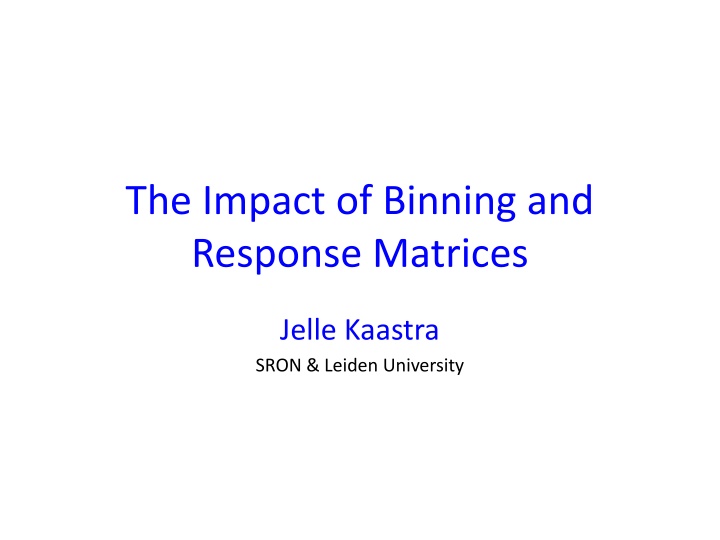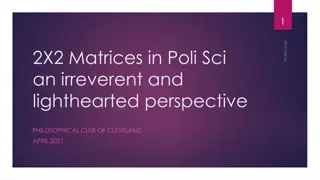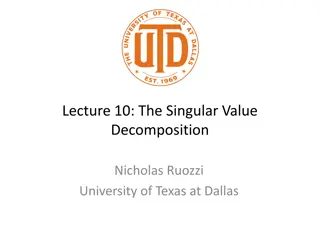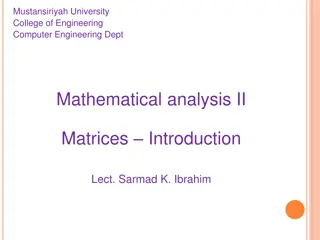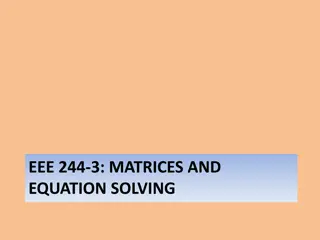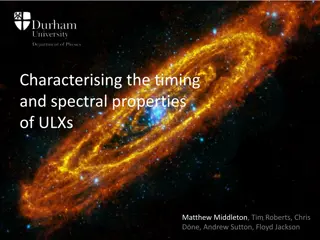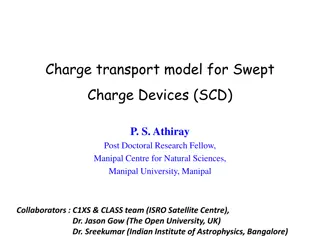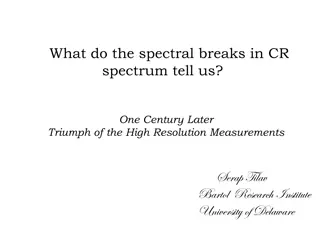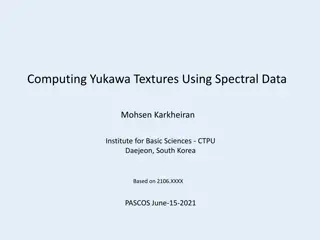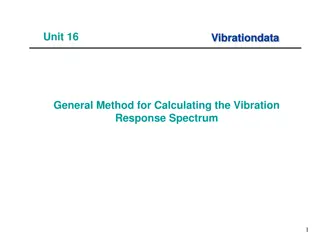Insights into Binning and Response Matrices for Spectral Analysis
Understanding the impact of binning and response matrices in spectral analysis, including energy bin properties, flux evaluation techniques, assumptions, and strategies for improvement. The discussion delves into challenges and solutions for accurate data interpretation and modeling in high-resolution spectroscopy.
Download Presentation

Please find below an Image/Link to download the presentation.
The content on the website is provided AS IS for your information and personal use only. It may not be sold, licensed, or shared on other websites without obtaining consent from the author.If you encounter any issues during the download, it is possible that the publisher has removed the file from their server.
You are allowed to download the files provided on this website for personal or commercial use, subject to the condition that they are used lawfully. All files are the property of their respective owners.
The content on the website is provided AS IS for your information and personal use only. It may not be sold, licensed, or shared on other websites without obtaining consent from the author.
E N D
Presentation Transcript
The Impact of Binning and Response Matrices Jelle Kaastra SRON & Leiden University
Introduction Transition low-resolution high-resolution Needs forward-folding Computationally intensive Example: RGS properly designed, classical response matrix needs ~100 Mb-sized storage & calculation; XRISM full responses even larger .... High-quality spectra can have dozens of free parameters; error search . Need optimal binning & design
Response matrices Distinguish two energies: E = photon energy (entering the instrument) E = count energy (as reported by instrument) S(E')= R( 0 E',E)f(E)dE Usually replaced by summation over discrete energy bins: Si= RijFj
Energy bins Bins have different properties: Lower limit energy E1j Upper limit energy E2j Bin centre Ej= (E1j+ E2j) Bin width Ej= E2j E1j Photon Flux Fj(photons/s/bin)
How to evaluate the bin flux Fj? 1) Bin center value: Fj= f(Ej) Ej Nice for continua 2) Integral over bin: E2 j Fj = f(E)dE E1j Nice for narrow lines (narrower than bin width) Not trivial, which option to choose?
Tacitly assumed. Most analysis: tacitly assume all photons @ bin centre Ej What if line at bin boundary? Line centre determined with accuracy / N FWHM = 2.35 for Gaussian, N = number of counts in line Example: CCD with 50 eV resolution, 10 eV model bins, line 400 counts: line centre determined with 50/2.35/ 400 = 1 eV accuracy line @ bin boundary off by 5 eV or 5 sigma significance! Solution: increase number of bins . But what if you study Capella (40000 counts in the strongest lines)?
How to improve on this 1. Resolution usually not constant over range, use resolution-dependent binning 2. Highest resolution only needed near high flux / strong lines: flux-dependent binning 3. Revisit way spectra are calculated: not only account for number of photons within bin, but also their average energy
Flux distribution within bin: order 0, 1 or 2 approximations f0(E) = true distribution f1,0= N (E-Ej) with Ejbin centre f1,1= N (E-Ea) with E 2 j Ea= f(E)EdE E 1j f1,2= N exp[(E-Ea)2/2 2)] with E 2 j 2 t= 2 (E- a f(E) E ) dE E 1j
Optimal binning (details, derivation in Kaastra & Bleeker 2016) From order 0 to order 1 improvement order of magnitude From order 1 to order 2 only slight improvement at lot of computational expense choose order 1 as best option (Data binning) Order 2 Order 1 ( SPEX recommended ) Order 0 ( classical approach)
Consequence for response design If response matrix is Rij with i observed count energy bin & j photon energy bin: Classical Response matrix New term: response derivative Si = Rij Fj + Rij (Ea,j Ej) Fj with the prime indicating differentiation with respect to photon energy (second index) Si is count spectrum, Fj incoming photon spectrum
Example: Capella LETGS spectrum 85 ks Chandra LETGS observation Range 0.86 175.55 Resolution 40 76 m Strongest line (Fe XVII) has 15000 counts
Example: Capella (continued) Binning Data Model bins Resp. elements comments bins 8.52x103 1.26x106 1.01x107 A Constant bin size (20 m data, 0.14 m model) 6.20x103 9.14x105 7.31x106 B Bin size follows resolution E 5.12x103 1.23x105 9.84x105 C Bin size follows resolution E & N; photons @ bin centre Ej Bin size follows resolution E & N; photons @ average energy Ea 5.12x103 8.21x103 6.57x104 D
Fine tasting Can use different binning for different components of the matrix: Example: CCD spectrum Diagonal needs fine binning but is narrow Partial events tail is broad but coarse binning sufficient This can save a lot of memory (& computing time!)
Why would you rebin? You do NOT loose any information by (optimally) binning Makes smaller datasets & matrices (less storage & computing time) Plots become clearer, easier to see the real differences If you don t, you loose discriminating power for models (see example)
Do not bin more than needed (i.e. do not bin beyond optimal) You my wash out important spectral features Thereby you loose discriminating power low counts are no problem: always use C-stat! can use C-stat even for spectra with ten counts (see Kaastra 2017) Caveat: use modeled or smoothed background when using C-stat (would hold also for ?2-statistics, by the way....)
Take care of proper calibration: effective area matters Relative difference simultaneous AGN (blazar) observations show systematic differences in fluxes calibration issues but what if they affect your nice line spectrum? 17
RGS 1-T model with power law effective area error kT = 4 keV Fit 1 not acceptable (too high Cstat) Fit 2 (free abundances) would be accepted Strong bias in T (> 1 keV!) Abundances too low (almost up to 2x) Errors on parameters underestimated (almost up to2x ) Parameter Input value Fit 1 Fit 2 True fit Norm 10000 9964 25 10213 28 10009 30 T (keV) 4 3.88 0.04 2.94 0.05 4.01 0.08 C 1 0.84 0.07 1.04 0.09 N 1 0.62 0.09 0.81 0.12 O 1 0.72 0.02 0.99 0.03 Ne 1 0.64 0.03 1.01 0.05 Mg 1 0.67 0.04 1.05 0.06 Si 1 0.61 0.05 0.93 0.07 Fe 1 0.56 0.02 0.99 0.04 Cstat 1116 47 1582 1177 1087 19
Conclusions Pay attention to binning: do not oversample your data choose optimal binning do not bin beyond optimal Design your response matrix carefully Take care that you can deal with calibration uncertainties
